Key takeaways:
- Distractions at work can arise from both external factors (like clutter and interruptions) and internal challenges (such as stress and anxiety).
- The Covid pandemic intensified distractions by altering work environments and reducing meaningful social interactions.
- Creating a distraction-free workspace, both physically and digitally, significantly enhances focus and productivity.
- Implementing techniques like the Pomodoro Technique and maintaining a distraction list can help improve concentration and efficiency.
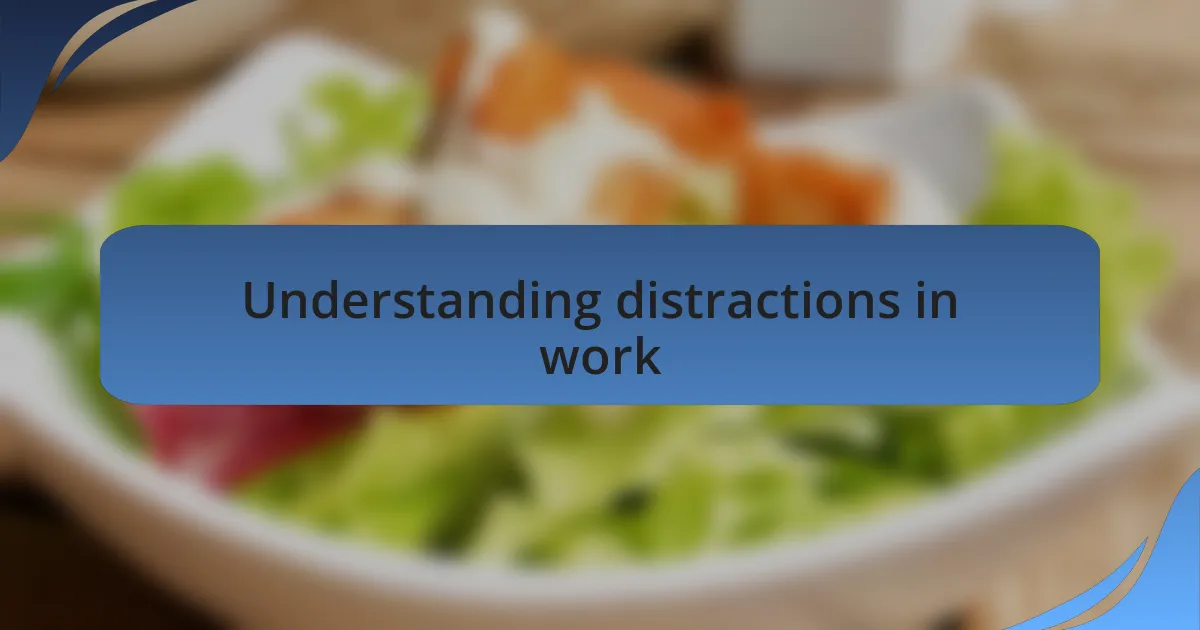
Understanding distractions in work
Distractions at work can come in many forms, from social media alerts to the chatter of coworkers. I recall a time when I found myself deep in a task, only to be interrupted by an unexpected phone call. That brief moment pulled me out of my flow, and it took longer than I’d like to admit to regain my focus. Have you ever experienced that sinking feeling when a distraction derails your productivity?
It’s interesting how our environment contributes to distractions. For instance, I’ve noticed that the clutter on my desk can be a significant source of mental distraction. Looking at a messy workspace can create a feeling of overwhelm, which makes it harder to concentrate on the work itself. Have you considered how your surroundings affect your ability to stay focused?
At times, internal distractions can be even more challenging. I often find that my own thoughts can become a significant hurdle, especially when I’m stressed or anxious about external issues. It’s as if my mind gets tangled in a web of worries, detracting from the task at hand. Has that ever happened to you, where your own mind becomes a distraction?
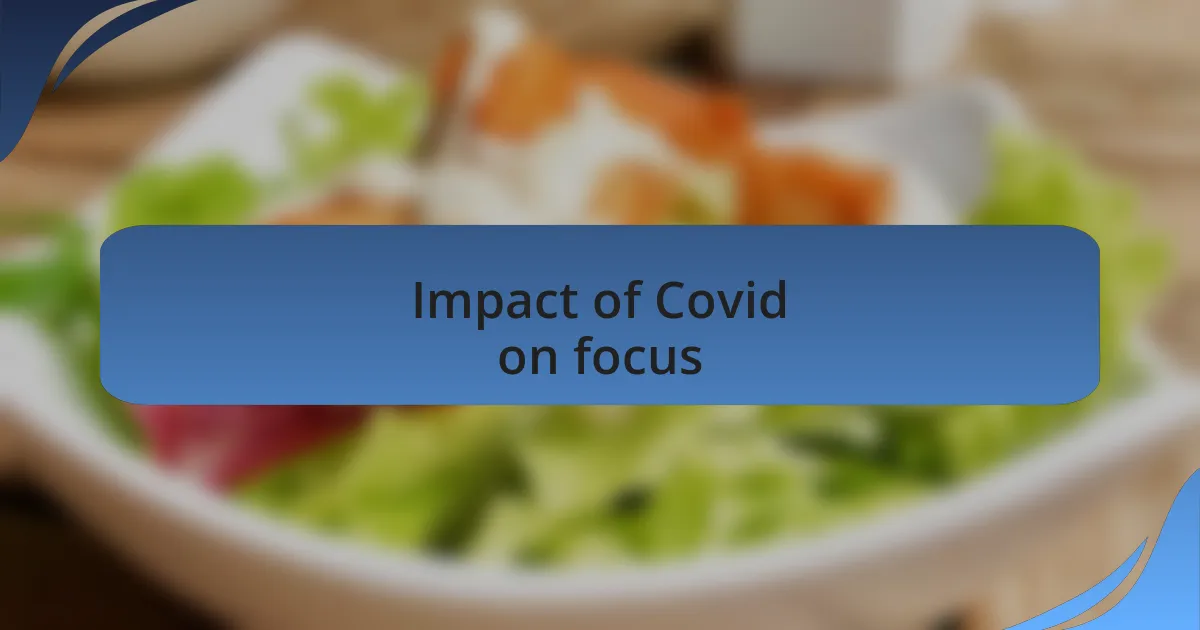
Impact of Covid on focus
The Covid pandemic has undeniably shifted our focus in profound ways. For example, I used to effortlessly immerse myself in work, but during lockdowns, my mind became preoccupied with fears and uncertainties about the virus. Have you felt that gnawing distraction when trying to concentrate, only to have thoughts of health, safety, or even financial worries creep in?
Moreover, working from home introduced a new set of distractions. I remember setting up my home office, hopeful about maintaining my focus. However, the noise from kids or the temptation to binge-watch a show during breaks often pulled me away from my tasks. Isn’t it challenging to draw the line between work and personal life when you’re sharing the same space?
Additionally, social interactions diminished, and that loss impacted my ability to stay engaged. I found myself missing those casual conversations with colleagues that sparked creativity. The isolation affected my motivation and focus since collaboration often fosters a sense of accountability. Have you experienced similar feelings when the connections we once took for granted fade into the background?

Importance of a distraction-free environment
Creating a distraction-free environment is crucial for maintaining focus, especially in the context of remote work. I remember the first time I removed all non-essential items from my workspace—it was like lifting a weight off my shoulders. Suddenly, I could direct my attention solely to my tasks without visual clutter competing for my mind’s eye. Have you ever noticed how a tidy desk can influence your productivity?
In addition to physical clutter, digital distractions can derail our concentration just as easily. I often found myself sidetracked by notifications from my phone or the allure of social media during work hours. To combat this, I decided to set my phone aside and limit screen time on non-work-related apps. This small change significantly improved my ability to dive deeply into tasks without the constant pull of digital interruptions.
Moreover, the ambiance of my workspace plays a vital role in how well I stay focused. Soft background music or ambient sounds can create a comforting atmosphere that enhances my productivity. Have you tried experimenting with different sounds or even silence? Discovering what works best for you can make all the difference in establishing a distraction-free environment.

Strategies to minimize distractions
Implementing the Pomodoro Technique has been a game-changer for me when it comes to minimizing distractions. I set a timer for 25 minutes and commit to focusing solely on my work during that period. After that, I take a short break. This structured approach not only keeps me accountable but also makes me more conscious of my time. Have you ever found that you work better with defined intervals?
Another strategy I’ve adopted is using “Do Not Disturb” modes on my devices during work sessions. It’s interesting how something as simple as turning off notifications can create a bubble of focus. I’ve noticed that when I eliminate pings and alerts, my mind feels calmer, and I’m able to engage more deeply with my projects. Isn’t it surprising how much quieter our minds can become when we’re not bombarded by constant notifications?
Lastly, I’ve also made a habit of planning my day the night before, which has significantly reduced my tendency to get sidetracked in the mornings. By knowing exactly what I need to accomplish, the clarity helps me stay on track. I can’t tell you how empowering it feels to wake up with a purpose. Have you ever tried mapping out your tasks ahead of time? It might just help you navigate your day more smoothly.
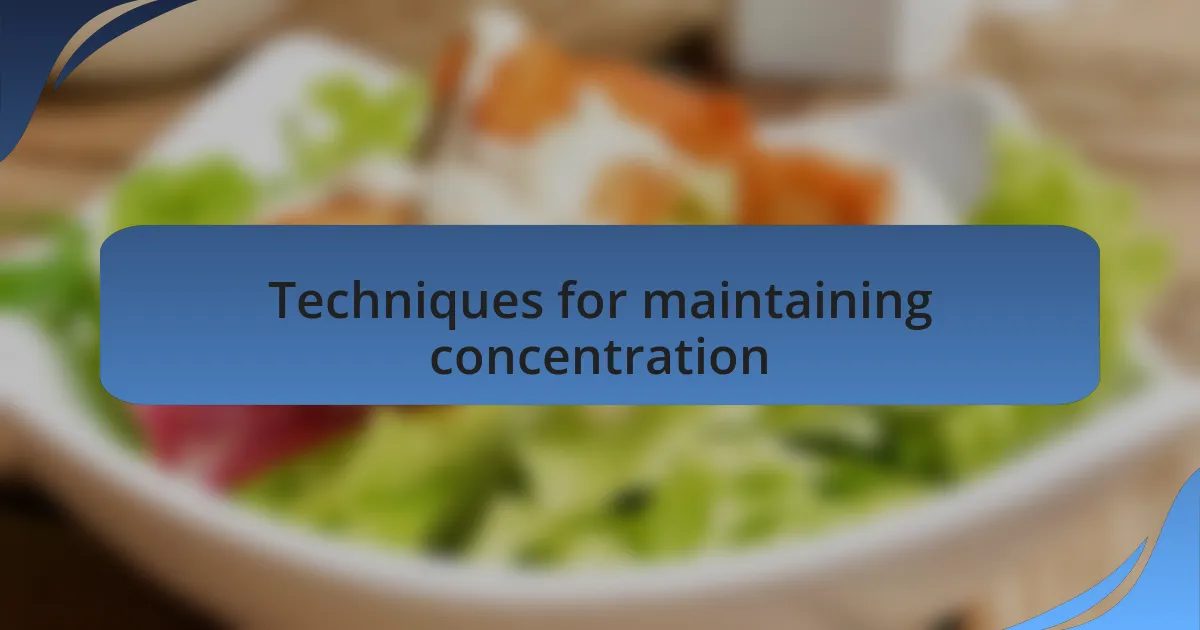
Techniques for maintaining concentration
One technique that I find tremendously effective is creating a dedicated workspace free from clutter. When I designate a specific spot in my home for work, I feel an immediate shift in my mindset. It’s incredible how surrounding myself with only what I need can clear my mind and boost my focus—sometimes, it feels like a visual cue that signals my brain: “It’s time to work.” Have you ever noticed how your environment can shape your productivity?
Another approach I swear by is incorporating short, mindful breathing exercises throughout my day. These moments of pause allow me to reset my focus and recalibrate my energy. I remember starting a session feeling overwhelmed, but just a few deep breaths can be transformative. Isn’t it fascinating how something so simple can ground us and bring clarity to our thoughts?
Lastly, I prioritize goal-setting with clear, measurable objectives for each work session. Instead of just saying, “I need to work on my project,” I’ll specify, “I will finish the first draft by lunchtime.” This kind of specificity not only fuels my motivation but also gives me a tangible way to track my progress. I can’t emphasize enough how satisfying it is to check items off my list. Have you found that defining your goals can make a difference in maintaining your concentration?
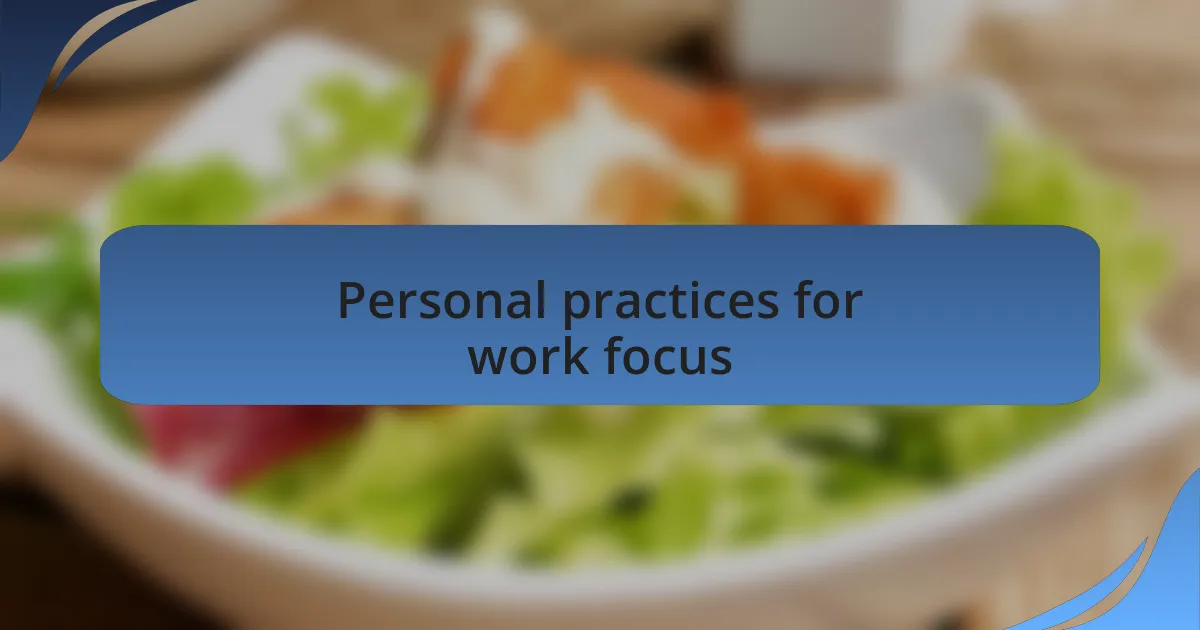
Personal practices for work focus
One personal practice that has significantly enhanced my focus is the use of the Pomodoro Technique. I set a timer for 25 minutes and fully immerse myself in a single task without any interruptions. After that, I take a short break to recharge. It’s like those 25 minutes transform into a small, focused sprint, pushing me to make the most of every moment. Have you ever tried working against the clock? It can turn the mundane into an exciting challenge.
Another habit I’ve found rewarding is maintaining a “distraction list.” As thoughts or tasks pop into my head—like remembering to buy groceries—I jot them down rather than act on them immediately. This practice keeps my mind clear and prevents those wandering thoughts from derailing my focus. There’s something freeing about knowing I won’t forget that idea. Have you ever experienced that satisfying feeling of clearing your mental clutter?
Mindful movement has also played a crucial role in sharpening my concentration. I often take brief walks or do stretches during my breaks, which helps refresh my mind. Recently, I stepped outside during a particularly difficult work session and found the fresh air reignited my creativity. It’s remarkable how a little movement can stimulate mental clarity—do you find that physical activity impacts your focus as well?
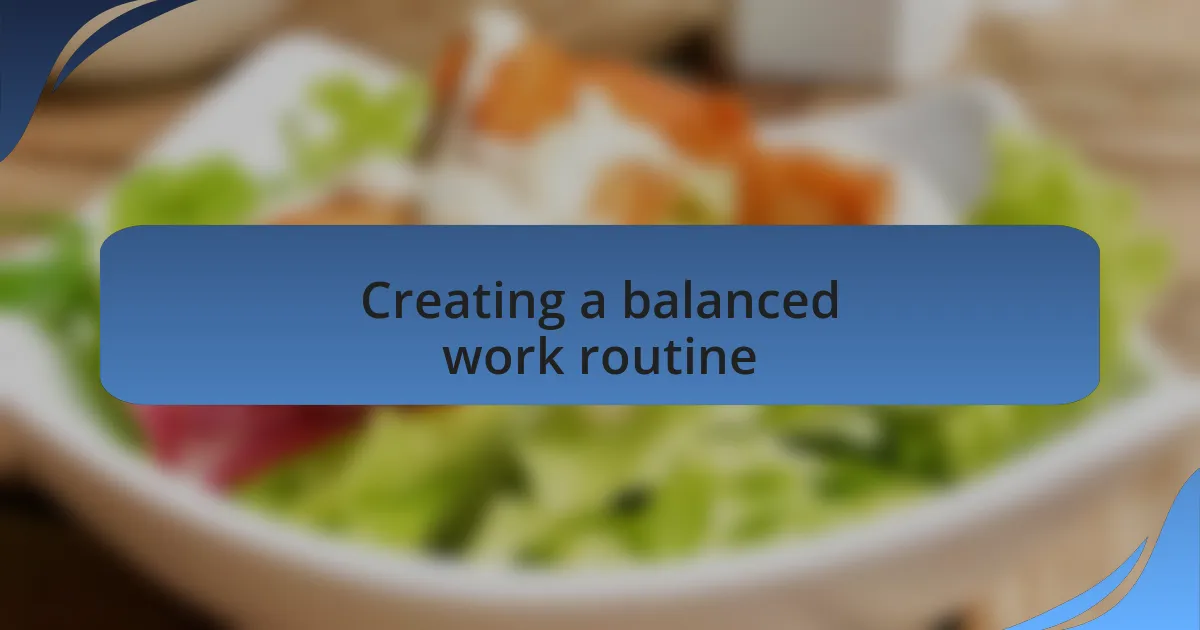
Creating a balanced work routine
Creating a balanced work routine requires scheduling flexibility while also setting clear boundaries. I’ve learned to carve out specific time blocks for work and personal life, ensuring that I don’t stretch myself too thin. On days when I overcommit, I feel drained and less productive. Have you noticed how essential it is to protect your time to maintain energy levels?
Additionally, I prioritize regular meal and hydration breaks, as I’ve found that neglecting these can lead to a decline in my focus. I set reminders to step away from my desk for a quick snack or a glass of water. It’s amazing how a simple snack can lift my spirits and sustain my motivation throughout the day. Have you experienced that refreshing feeling after a quick break?
Another aspect of balance I value is having clear “no work” zones. I make it a point to keep my living space distinct from my work area, which helps my mind shift gears effectively. When I enter my work zone, I’m in “work mode,” and once I leave, I switch to “home mode.” This separation has allowed me to fully engage in both areas without the mental clutter overlapping. Have you ever thought about how your physical space influences your mental state?